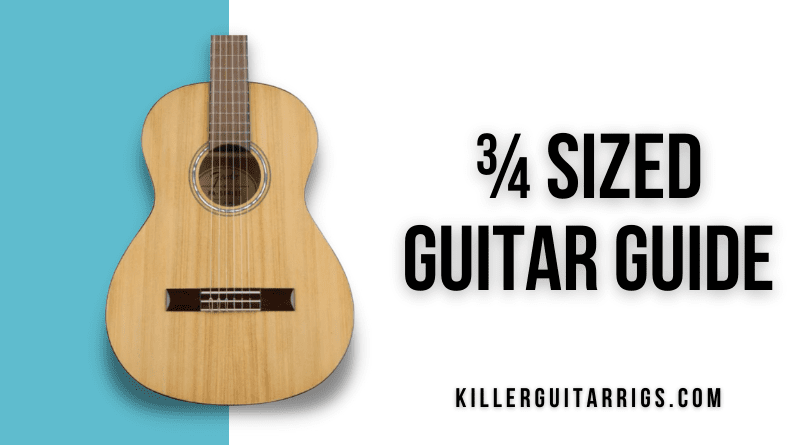Over the years, the humble guitar has developed in so many ways to improve the sound and just as important, the playability of the instrument. When it comes to the playability of the guitar, few things affect this more than comfort.
It’s all well and good having the perfect action height, rolled fretboard edges, and huge cutaways, but all of that means nothing if you can’t comfortably hold the instrument. Enter the reduced size Guitar.
In this KillerGuitarRigs Guide, we’ll be taking a look at the 3/4 size guitar in all of its forms, we’ll be talking about some of the more common applications, and some you might not even have thought of.
In addition to the guide, we’ve also provided reviews of the top 3 3/4 size guitars in the electric, acoustic, and classical categories – not to be missed if you’re thinking of purchasing a new 3/4 sized guitar!
Read more about our review process.
Contents
How To Choose the Right Guitar For You
Choosing a 3/4 size guitar requires an understanding of several factors, including how to measure a guitar, and also the best use cases for these reduced size models.
What is a 3/4 Size Guitar?
If you’re wondering what makes a guitar a 3/4 size model, you’ll need to take a look at its overall length – typically, a 3/4 size guitar is one that has a total length of under 36”.
In the guitar context, the use of 3/4 is actually quite misleading, because a 36” and above guitar would be considered full size, and 35.9” isn’t anywhere near 3/4 of 36”.
How to Measure a Guitar
Measuring a guitar is a little more complicated than just figuring out the length from top to bottom. Read on as we discuss the different measurements to consider.
Total Length
When measuring total length, this is the measured distance between the tip of the headstock and the furthest point on the body. In the case of traditionally shaped guitars this is usually on the centerline, but when looking at asymmetrical guitars, the furthest point at the bottom of the body can be significantly offset from the center.
Total length tends to affect playability in terms of ergonomics, as in, how comfortable the guitar is to hold, and how easy the guitar is to transport and carry.
Scale Length
As we’ve established, using quarters isn’t always practical way to measure a guitar, and to find the best 3/4 sized guitar for your needs, you’re sometimes better off considering its scale length. The scale length is the distance between the nut and the saddle. This is ultimately a measure of the freely vibrating portion of your strings.
The scale length affects playability in several ways. Short scale guitars have lower string tension, which makes them easier to play, but can cause issues with tuning stability. In addition, the fret spacing is smaller, making it easier for players with smaller hands to reach for chords.
Who are 3/4 Sized Guitars For?
3/4 Size guitars are suited to everybody. Tall and short, young and old, the 3/4 size guitar has uses that extend way beyond the obvious.
Are 3/4 Size Guitars Good for Kids?
Kids and younger players can definitely benefit from using 3/4 size guitars rather than full size when they start out. The smaller size of the guitar will promote better form, and allow them to learn the basics the right way, rather than having to work around ergonomics issues on a full size model. Of course if the 3/4 size is too small, a 1/2 size guitar might be a good starting point.
Are 3/4 Size Guitars Good for Adults?
Adults of all ages and sizes can absolutely use 3/4 size guitars. For the same reason as children using these reduced size guitars, smaller adults, and particularly those with shorter arms and smaller hands will enjoy the improved ergonomics of a smaller guitar.
Even larger adults will find that 3/4 size guitars are great for noodling on the couch, or to have standing by at a desk in case songwriting inspiration strikes and they need to grab something quickly.
Are 3/4 Size Guitars Good for Travel?
Full size guitars being longer, are usually much more difficult to transport, making 3/4 size guitars great as travel guitars. 3/4 Size guitars can provide a means for players who are normally comfortable with full size guitars to take their instrument with them on their travels, with a reduced risk of damage due to their convenient size
Individual Reviews (Acoustic)
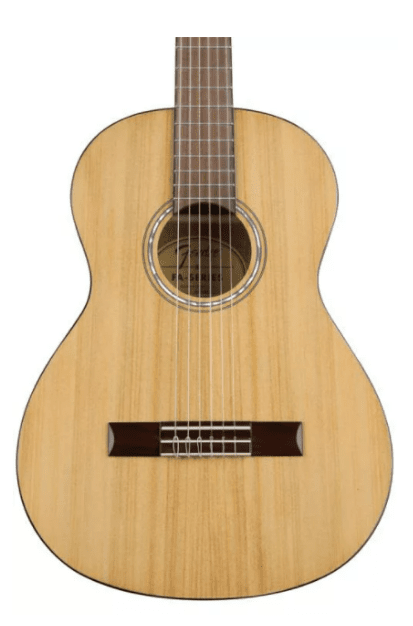
Fender FA-15
Classic looks and legendary Fender quality.
With this ¾ size acoustic guitar, you’re getting a reliable guitar from one of the biggest names is music. It trades luxury woods for great build quality and exceptional durability. It’s handsome, comes in a range of colors, and works well for smaller and larger players alike.
The Fender FA-15 was a KGR favorite – we loved the range of colors, which includes, black, blue, moonlight burst, and red. The red finish that we received to test looked even better in person than it did in the pictures. The design was quite low key, with a super simple rosette, and no binding, but regardless, it looked great.
It had an all laminate construction, which is a great way to keep costs down while simultaneously improving the durability of the guitar. The top was laminated agathis, which is a great spruce alternative. It provided great punch, and strong presence in the mids and upper registers. The back and sides were laminated sapele, which is a wood in the mahogany family. This provided some warmth, and balanced out the tones with some nice bottom end.
It had a nato neck with a comfortable C shape profile. It felt good in the hands, and thankfully the gloss polyester finish didn’t gum up the feel or slow it down at all.
This was a dreadnought style guitar, and despite being 3/4 it still had a big presence. The reduced size made this guitar a great choice for those who always wanted to get into a dreadnought guitar, but felt that the bulky shape was prohibitive, comfort wise.
Once we got it to pitch it held really well. It was equipped with closed gear tuners in a traditional 3×3 layout, unlike some of Fender’s more contemporary guitars that use a Strat style headstock.
Verdict: Considering that the Fender FA-15 retains the Fender logo on the headstock, and hasn’t been branded as a Squier, this guitar represents excellent value for money. We loved the tones, and the fact that they’re made well, and come in a variety of colors to suit all tastes was the icing on the cake.
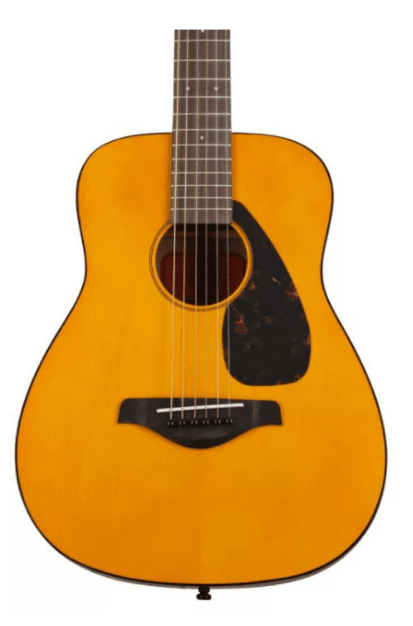
Yamaha JR1
Unique woods and a surprisingly premium feel.
It’s well known that Yamaha make great acoustic guitars at all price points, and this model really proves that the formula applies to reduced size guitars too. It’s made with quality woods that really work well tonally, and the construction quality is unbeatable at this price.
Once again, we found that a Yamaha was able to provide insane quality at an unbelievable price – in this case the Yamaha JR15. This was a traditional looking guitar that was made with the kind of care and attention to detail that keeps people going back to the brand.
This 3/4 guitar was constructed with a spruce top, and meranti back and sides. The spruce gave it a bright and peppy tone that did much of the leg work tonally. The back and sides were meranti, which is sometimes known as Philippine mahogany. It’s not a direct relative of mahogany, but it does share some tonal traits, including warmth and great resonance. The guitar was, relatively speaking, quite heavy, but this was likely down to the meranti.
It had a dreadnought shape, with a simple 2 line rosette, black binding, and a lovely faux tortoise shell pick guard. The top had an aged stain that really stood out, making it look much more like a high end model.
The nato neck was comfortable and slick, and around the front, it was topped with a lovely rosewood fretboard, which is definitely unusual at this price point. It felt good and looked even better.
As for tones, this was a beautifully balanced guitar. It had a nice, full bottom end, which gave it great presence and volume. The mids were tight, and up at the top, it was shimmery and clean. Again, considering this guitar is just a hair over $150, it sounded incredible.
The tuners were vintage Kluson style, they worked really nicely, and we’d probably belive that they were real Klusons if we didn’t know any better. It held tune brilliantly and was an overall joy to play.
Verdict: For very little money, the Yamaha JR1 offers a lot. It looks fantastic, it sounds ruch and full, and it offers great comfort and playability, whether you’re a young player looking for a guitar that is the perfect fit, or you’re a larger guitarist looking for a bargain travel guitar.
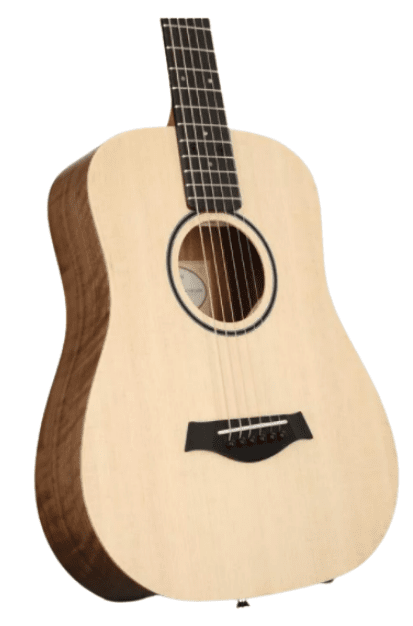
Taylor BT1 Baby Taylor
One of the finest ¾ size acoustic guitars on the market.
If you’re looking for the best when it comes to ¾ size guitars, this Taylor is the definitive answer. It’s made to the same standard as you’d expect from any Taylor guitar, using the best woods, high end hardware, and even comes with a fantastic heavy duty gig bag.
The Taylor BT1 Baby Taylor is a 3/4 size guitar, with a classic dreadnought profile. It brings Taylor quality and style to a wider audience, and that’s definitely a good thing.
The top was solid Sitka spruce, widely considered the gold standard of tone woods for acoustic guitar tops. It gave us some amazing tones, with enormous presence, thick, punchy mids, and tons of sparkle at the top end.
The back and sides were layered walnut. This gave it a bit of a lighter color than you’d find on something with mahogany, but being layered, we didn’t really think it had much effect tonally.
If spruce and walnut isn’t your thing, this model is also available in all mahogany, koa, or if you want the Taylor Swift model, Sitka spruce and sapele.
As with the other steel string acoustics we tested, it had a really simple rosette. This is becoming much more common, and may be more of a sign of the times than a cost saving measure.
When it came to playability and performance, this guitar was phenomenal. It offered peerless tuning stability amongst other 3/4 size models, and was perfectly intonated. It had a great mahogany neck, and even had an ebony fretboard. The body was extremely comfortable to hold and play, whether seated or standing, and this was the case for both smaller and larger players.
Verdict: We had a great time trying out the Taylor BT1 Baby Taylor. While it was notably more expensive than the other acoustics on test, in the scheme of things, you’re still getting a lot of guitar for the money. It was loaded with top quality features and high end appointments, so it really isn’t a case of “just paying for the name”. It’s an overall wonderful guitar, and if you’re looking for the best of the best in 3/4 size, you’ve found it!
Individual Reviews (Classical)
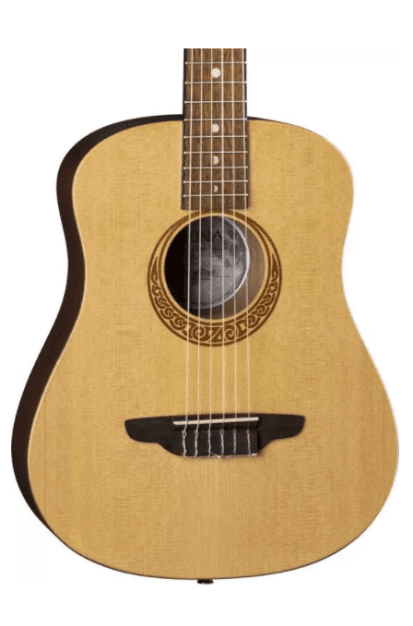
Luna Safari Spruce Travel
Steel string style and comfort with nylon string tones.
This Luna guitar is a great choice for players who don’t necessarily like the look and feel of a traditional acoustic guitar, but who do enjoy the tones and comfort of nylon strings. It offers a great standard of construction and some nice design features that help it to stand out.
The Luna Safari Spruce Travel offers an unusual take on the classical guitar, but regardless, we really enjoyed our time with it. It’s closer in profile to a dreadnought than it is a typical classical shape, and that definitely influenced the tones and presence.
It had a select spruce top, which again is a departure from the cedar that is traditionally used on classical guitars. It was brighter than expected, although not as punchy as a steel string model would have been. The back and sides were mahogany – the back in particular had a really nice grain.
The C shaped neck, which was also mahogany, had a nice satin finish, and was effortlessly playable. At the front, the neck was capped with a walnut fretboard. Now that rosewood is getting less common, walnut seems to be getting more popular, and we couldn’t be happier. The walnut fretboard on the Luna felt great, and combined with the pearloid “moon phases” inlay, looked brilliant.
The tones were rich, and yet, they had a surprisingly detailed top end. The dreadnought body shape, despite the smaller size, gave this miniature classical style guitar a lot of room presence, with a full voice and ample volume.
The stock strings did take quite some time to stretch before they’d hold tune properly, but this can be said of almost all nylon strings. We did like the performance of the open gear tuners, though.
Verdict: As a final note, the Luna Safari Spruce Travel was full of great design touches that really made it stand out, and even included a nice, padded gig bag. The laser etched Celtic design rosette was a particular highlight, and the headstock logo was also one of the coolest we’ve seen. The tones were great, and the comfort and playability were outstanding.
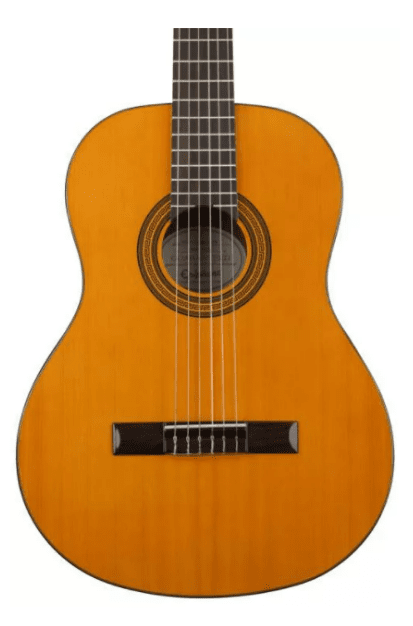
Epiphone PRO-1 Classic ¾ Size
Traditional styling and great build quality.
This is a great classical guitar option for those looking for a scaled down option from a well recognized brand. This ¾ sized Epiphone offers the usual array of classical guitar appointments, along with thoughtful features like a reduced nut width to improve playability for smaller players.
The Epiphone PRO-1 Classic is very much a real classical guitar. It has the 000 style body profile, and even more telling, it has the traditional wood selection, with a cedar top and mahogany back and sides. The cedar offered a more direct response to changes in attack than the spruce on the Luna, and ultimately had a more percussive sound, which made it ideal for classical styles.
Tonally it had all the hallmarks of a cedar topped guitar. It was noticeably darker sounding than the spruce alternatives, but it was also fuller and richer in tone.
It had a slim and comfortable neck in a D profile. The finish on the back was quite glossy, which did make it a bit tacky under certain conditions, but it largely performed well. The neck was made from mahogany, and was well set up right out of the box. The scale length was significantly shorter than a full size classical at just 22.8” vs 26” on a full size model. It made some of the more technically challenging aspects of playing classical guitar just a little bit easier, so kids and adults alike will appreciate that.
One of the simplest touches on this guitar also made it incredibly user friendly. Epiphone installed 2 strap buttons, which allowed for the easy addition of a strap – typically, classical guitars don’t come with strap buttons, so this was great to see.
Verdict: We were really impressed by the Epiphone PRO-1 Classic. It offered excellent performance for a budget guitar, and will definitely serve the needs of those looking for this style on a tighter budget. Thanks to the use of cedar, it offered traditional classical tones, and the reduced size really made it comfortable to hold.
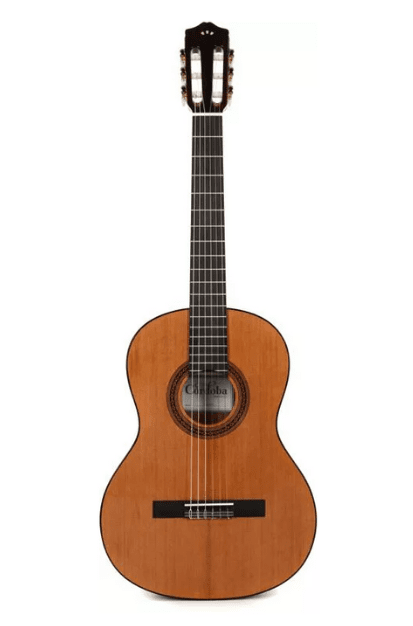
Cordoba Cadete
A true classical guitar with tones as beautiful as its looks.
This is simply one of the very best ¾ classical guitars on the market. It uses top quality Canadian cedar for the top, giving it tons of character, and a warmth that spruce could never match. Build quality is absolutely superb, and all things considered, it’s much less expensive than its feature list alludes to.
The Cordoba Cadete represents a culmination of experience in classical lutherie from a relatively new brand (founded in 1997). Cordoba has taken everything they’ve learned about making quality Spanish style guitars, and condensed it into a user friendly 3/4 size instrument that works well for kids and adults alike.
It featured a solid Canadian cedar top, which really looked fantastic. Getting a solid top on a classical guitar at this price is almost unheard of, let alone one with a grain pattern quite this nice. It provided a beautiful, rich tone that was warm, but still punchy with percussive strumming. The back and sides were layered mahogany, which not only looked great, but will also make the guitar much more durable in the long term.
The neck was made from solid African mahogany – we found it to be slim and very forgiving, and with a 1.88” nut width, it was narrow enough to be comfortable, while still providing a great transition point to a full 2” nut for anybody thinking of transitioning to a full size classical. It even featured a rosewood fretboard and bridge.
As far as design was concerned, this model was classic in every sense. It had a lovely, intricate rosette, and black binding on the top. The hardware was great quality, and the gold colored tuners worked really well. Of the three classical models we tested, the Cadete offered the best tuning stability, and really required the least time to stretch in the strings.
Verdict: Classical guitar can seem intimidating to many, but, the Cordoba Cadete offers a user friendly size to keep newer players comfortable, and the type of high end fit and finish that will keep intermediate players happy. It sounded wonderful, and offered performance that would rival a guitar twice its price.
Individual Reviews (Electric)
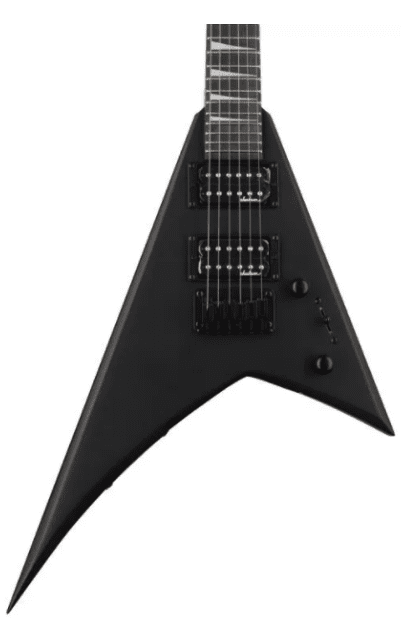
Jackson JS RR Minion JS1X
An aggressively styled guitar with excellent playability.
This guitar is fantastic to look at, comfortable to hold and play, and sounds epic. It features string through construction for awesome resonance and sustain, and dialing in tones has never been easier. At this price, it’s an absolute steal.
This awesome looking Jackson V is a scaled down version of their Randy Rhoads signature model, and it might just be the coolest reduced scale guitar on the planet. It’s made with a graphite reinforced neck, that helps significantly with the guitar’s structural integrity.
We loved the purple heart (AKA amaranth) fretboard. It looked fantastic, it offered great feel and snappy response, and as one of the harder woods available, it’s going to last a long time, too. Despite the fact that it has just a 22.5” scale, it still features a full 24 fret layout, making this the perfect axe for solos and other lead work.
Most players will find the neck to be extremely fast, and younger guitarists and those with smaller hands will find the slim neck to be comfortable and very forgiving.
Tuning stability was a strong point with this guitar – many short scale guitars struggle to stay at pitch due to the lower tension, but even after some pretty rigorous play, we didn’t find ourselves needing to tune up too often. The hardtail bridge design absolutely helps the tuning stability, but the high quality tuning machines were the biggest contributor.
It was fitted with a pair of ceramic humbuckers and a 3 way selector switch. They were really well balanced overall, but their mid range presence was the most impressive facet. In the neck position we got some nice warmth, and down in the bridge position we got some great crunch with the gain cranked and superb clarity with the volume rolled back and the gain set low.
Verdict: The Jackson JS RR Minion JS1X was a big surprise. V Guitars aren’t always particularly comfortable, but we found the asymmetric cut of the body to be comfortable in bot seated and standing playing positions. It looked awesome, sounded great, and had the fit and finish of a much more expensive model.
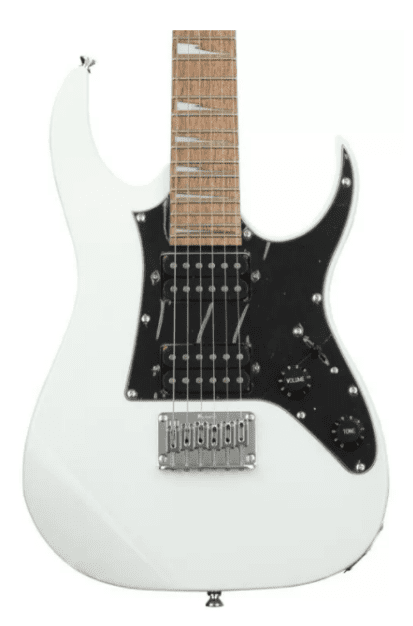
Ibanez Mikro GRGM21
A super-Strat on a shoestring budget.
Ibanez got it right with this ¾ size model – it looks great, offers the classic tones most guitarists want in this style of instrument, and considering the low cost, it’s extremely well made. It’s available in a range of great colors, and is perfect for anyone of any age looking for a comfortable, short scale guitar.
This S Style Ibanez Mikro GRGM21 was a real head turner – our test model was finished in Jewel Blue, but it’s also available in black, white, and metallic purple. The finish quality was fantastic, with deep color and well applied top coat.
It had a maple neck, and a maple fretboard. The back of the neck had a really nice satin finish, keeping it smooth and slick, and the GRGM neck profile, which is just marginally bigger than a wizard neck, was super fast, and definitely comfortable for smaller hands. Like the Jackson, it had 24 frets, giving a huge range of notes to explore, despite the fact that it had an ultra short 22.2” scale length.
Tuning stability was good, although perhaps not quite as strong as the Jackson out of the box. The tuners themselves were good, but the plastic nut was a weak point – with asn upgrade to Tusq or Nubone we think this would be much improved.
The pickup layout was 2 ceramic humbuckers, one at the neck and one at the bridge. The pickups were really clear across the board, with a really prominent top end. The bridge position played hot, and distorted nicely with high gain, and in the neck position it was pretty rich and full sounding.
Verdict: The Ibanez Mikro GRGM21 is one of the cheapest electric guitars available from a recognized mainstream brand, and you will not be disappointed. For well under $200 you’re getting a well made guitar, made with good components, and quality electronics. There are tons of aftermarket upgrades available for those who want to mod, but even if you want to leave it stock, it’ll provide great tones, and top level comfort.
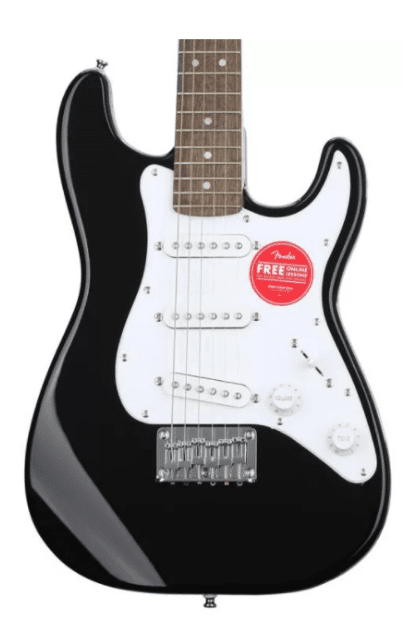
Squier Mini Stratocaster
Like a regular Stratocaster… Only smaller.
For classic looks and tones, this Mini Stratocaster checks all the boxes. As a Squier, this is an officially licensed Stratocaster, not just an S Style. You’ll get the chime and quack you’d expect from any other Stratocaster, all in a comfortable, ¾ size package.
It was quite jarring to see what we know as a Stratocaster in a size this small, nevertheless, the Squier Mini Stratocaster really did look great. Smaller players will absolutely love having a Strat that better fits their dimensions, and those looking for a travel Strat will dig this too.
It’s available in 3 colors, Shell Pink, Black, and the color we had to test, Dakota Red. All 3 color options come with the same maple neck. The neck profile was a comfortable slim C, which really promoted good form. The fretboard was Indian laurel, which is a Rosewood substitute. It felt nice under the fingers, and the lighter color suited the color of the guitar well.
It had a 22.75” scale length, which was a little longer than both the Jackson and the Ibanez. Regardless, it was still extremely playable.
It came with the classic 3 single coil pickups that the Strat is so famous for, and also had the 5 way pickup selector switch, which made it possible to dial in a huge range of tones. As you’d expect, the neck was warm, but we never found that it got muddy. The mid positions offered some great blues tones, and down in the bridge, we got some great top end that cut through a mix nicely.
The tuners aren’t quite as smooth turning as we’d like, so tuning did take a bit longer than we’d hoped for, but once we got it to pitch, it held strong.
Verdict: The Squier Mini Stratocaster follows the recipe for success that the full size model has been using for decades. We loved the build quality, and we also loved that we didn’t have to compromise on the Strat tones – it was set up almost identically to a full size model, including the ergonomics, making it one of the most comfortable 3/4 size guitars on the market.
Final Thoughts
Relying on one measurement alone isn’t a great way to shop for guitars. You’ll find that some manufacturers make their guitars 3/4 size, but keep them full scale – this can be great if you’re looking for a travel guitar, but if you’re looking for something for a child, they may still have difficulty with the full scale fretboard. Take into account the full picture, and you’ll find the perfect guitar for you.

